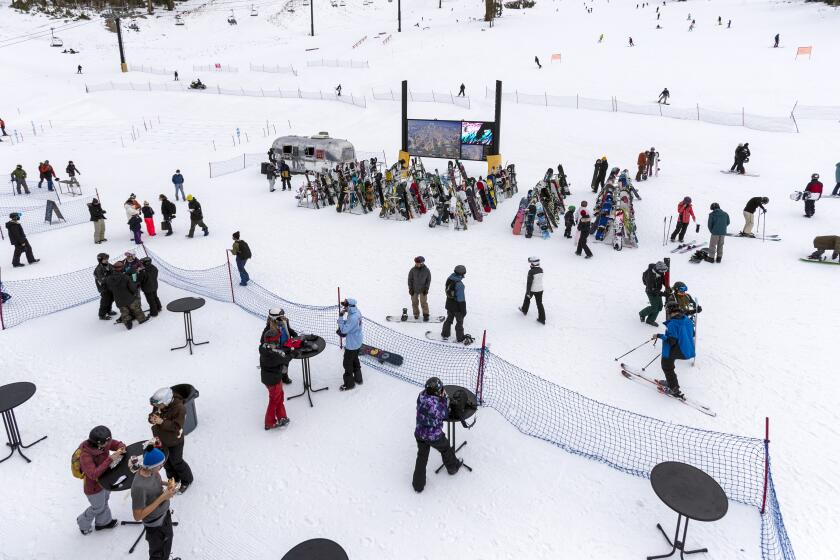If you thought 2020 was backward, wait till you see uphill skiing
- Share via
Uphill skiing is not an oxymoron.
It’s long been the domain of ski mountaineers, who “skin” up mountain sides using specialized alpine touring or randonée equipment and then carve turns down backcountry slopes. This rigorous activity has been gaining popularity in recent years at alpine resorts — and now among those who want to avoid ski lifts during these pandemic times.
It’s expected to boom this winter, as COVID-19 continues to ravage the country, experts predict. Nick Sargent, president of Snowsports Industries America, said sales of uphill skiing gear for use in the backcountry took off last spring after resorts were shut down because of the pandemic. Sargent, himself an uphill skier, predicted sales of this type of gear will outpace last season’s significantly.
At Mammoth and elsewhere, overnight visitors are banned and confusion persists.
“People are looking for alternatives to resort skiing, in part because of the pandemic,” he said. “This activity offers great exercise, fresh air, easy social distancing and a different approach to enjoying the snow. You don’t have to be an Ironman or -woman to do it, though it helps to be in good shape.”
Mammoth Mountain in Mammoth Lakes, Calif., offers designated uphill runs. Mountain High near Wrightwood lets skiers trudge uphill to ski down, provided they follow the rules.
Sargent also predicted that continuing concerns about COVID will lead to an increase in other winter activities, including snowshoeing, cross-country skiing, fat-tire biking and ascending slopes on telemark skis and split boards, which are essentially snowboards cut in half.
Don’t be surprised if you see more and more people lifting their heels and striding up downhill runs at resorts this year. Once at their lofty destination, they’ll catch their breath (some will change out of sweat-soaked gear), and pull off the climbing skins that give them traction from the bottom of their skis before they begin their descent.
Laura Beardsley, who runs the Disabled Sports Eastern Sierra program at Mammoth Mountain, sometimes skis uphill several times a week at her home resort. She often strides from the Eagle Lodge at the Mammoth base to the top of Lincoln Peak, an ascent of more than 2,154 vertical feet that takes her about 90 minutes. She also likes to head into the wilderness on occasion to climb slopes that offer untracked snow.
“I get funny looks all the time at Mammoth from people riding the lifts or skiing downhill,” she said. “It runs the gamut of reactions: Some cheer you on, others question your sanity and still others are just curious. Some just shout ‘You’re going the wrong way!’ ”
The uphill routes at Mammoth are generally on blue and green (easy and intermediate) runs, but skiers can descend on black diamond or double black diamond (difficult to expert) slopes, depending on their ability. Three uphill trails were added this year for a total of six at Mammoth, one of which goes all the way to the resort’s 11,053-foot summit.
Get The Wild newsletter.
The essential weekly guide to enjoying the outdoors in Southern California. Insider tips on the best of our beaches, trails, parks, deserts, forests and mountains.
You may occasionally receive promotional content from the Los Angeles Times.
Beardsley, who grew up in New Hampshire and began skiing at age 6, said she carries a helmet, extra layers of clothing and a heavier pair of gloves in a pack on ascents so she can stay comfortable on downhill runs “because you’re obviously a lot warmer when you are climbing.”
She has two pairs of climbing skis: a shorter and lighter pair for resort travel and a longer and sturdier one for the backcountry. But she said the most important piece of gear are boots that are comfortable and have a good range of motion in the walking and striding mode, which is what skiers use to ascend the slopes.
At Mammoth, uphill skiers can take a lesson or hire a guide to skin up the mountain. Other resorts that allow uphill skiing in the Sierra include Heavenly Valley, Diamond Peak, Kirkwood, Northstar and Sugar Bowl. In Utah, Brighton, Powder Mountain, Beaver Mountain and Cherry Peak permit skinning.
“I like both resort and backcountry skiing,” Beardsley said. “But for a great workout during my lunch hour, I can’t beat heading up the mountain here at Mammoth.”
Welcome to our comprehensive gift guide for the 2020 holiday season.
For uphilling in the backcountry, the Snowsport Industries’ Sargent, Beardsley and Howie Schwarz, who runs Sierra Mountain Guides in Bishop, Calif., all said it’s wise to take a basic alpine touring class to learn about the gear. Then follow that up with an avalanche course because there are no ski patrollers in the wilderness knocking down potential snow slides.
“Once you get away from resorts, it’s really important to understand the terrain and the snow conditions so you can make good decisions,” Schwarz said. “As more and more people get into backcountry skiing, the potential for people to get in dangerous situations will grow.”
Schwarz, whose outfit offers a variety of climbing and skiing courses, said it’s best for skiers to know how to use their equipment before taking an avalanche course.
“It’s hard to teach sometimes when all your bandwidth is spent answering really basic questions like ‘How do my bindings work?,’ ” he said. “Beyond that, avalanche classes cover essential things like route selection, transitioning from the uphill to descent mode, handling your skins and skis properly and planning a descent that minimizes risk and exposure.”
Schwarz said his company’s winter courses are filling up from increased demand and that he’s working to expand teaching programs.
“It really is important to take a course or hire a guide,” he said. “Just because you are a competent or even expert skier at a resort doesn’t mean you have the knowledge to go outside those boundaries safely without putting yourself and others in danger.”
How to get started
Uphilling, also known as skinning, means striding and gliding (like cross-country skiing) up a slope. Most participants use alpine touring or randonée skis, skins, boots and poles. Once at your destination, you take off your skins, make adjustments to your bindings and descend.
The sport requires a gear combination that differs from normal alpine equipment, as well as climbing skins that affix to the bottom of skis with an adhesive grip on one side and hairs on the other that provide traction for ascent.
- Alpine touring boots resemble regular alpine ski boots, but have adjustable cuffs that can be unlocked for easier walking and striding uphill — or locked stiff for skiing. Most are more flexible and lighter than alpine boots. Likewise, alpine touring bindings have two settings, one for skinning uphill with an unlocked free heel and the other a locked-down setting for skiing.
- These bindings have pivoting devices at the toe that let you raise your heels off the skis with each step while keeping the toe of your boot firmly locked in place. At your destination, you clamp the heel piece of your boot back into the binding and descend just like you would with traditional downhill bindings.
- You might want adjustable-length poles with longer settings for climbing and shorter ones for descents. You’ll want to carry a pack with a shell for wind and snow protection. You’ll also need layers for staying comfortable because you’ll be hot ascending and cold descending, a helmet for your downhill run, warm gloves or mittens, food and water.
- Resort skiing should be safe because ski patrols reduce dangers such as avalanches and mark hazards. But that’s not the case in the backcountry, so be aware of snow conditions, go with a guide or take an avalanche safety course. In addition, carry a shovel, probe, other rescue gear and a cellphone with a charged battery. And let someone know where you are going. It would also be wise to first become comfortable with your gear on resort slopes.
More to Read
Sign up for The Wild
We’ll help you find the best places to hike, bike and run, as well as the perfect silent spots for meditation and yoga.
You may occasionally receive promotional content from the Los Angeles Times.








